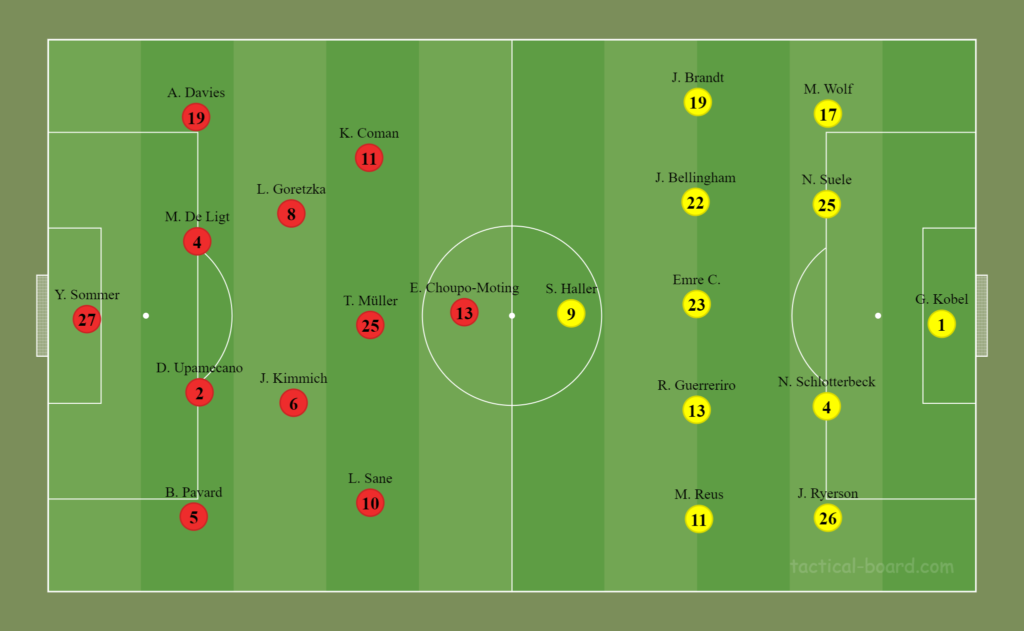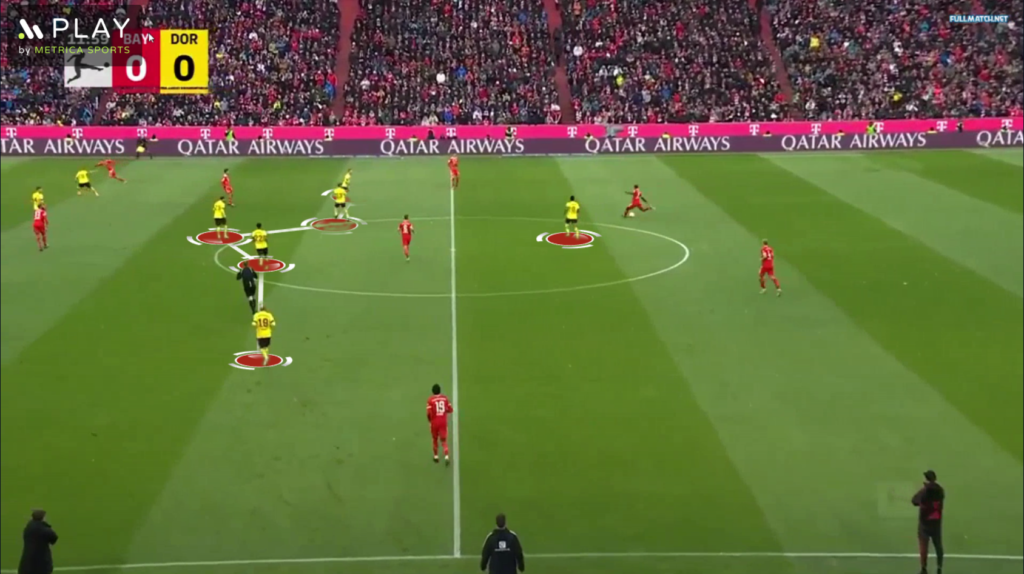In the 26th week of the Bundesliga, Germany's two biggest teams faced each other. Bayern Munich hosted Borussia Dortmund at the Allianz Arena. There was no shortage of goals with 6 goals scored in total, in the end Bayern Munich came out on top with a score of 4-2. This match was of great importance as it was Thomas Tuchel's first match after Nagelsmann's departure. Despite the fact that it was his first match, Tuchel managed to come out victorious and moved 2 points ahead of Borussia Dortmund in the race for the title. In the German derby "Der Klassiker", the starting 11s of the two teams were as follows:

BAYERN MUNICH IN POSSESSION:
Even though the possession rates were very close with 48% to 52%,Bayern Munich was in control throughout the match . Bayern Munich lined up in a 2-3-5 formation during their attacks. In the forward 5, Coman and Sane spread out wide on the flanks and provided width, Choupo-Moting played up front and Müller and Goreztka were positioned in the half space. Tuchel wanted to exploit Kimmich's passing ability, so Kimmich would frequently drop back and receive the ball during attacks. As a testament to this, Kimmich was the player who attempted the most passes and had the most possession throughout the match. Borussia Dortmund therefore tried to avoid this by matching up Kimmich with Bellingham, but Kimmich still frequently ended up with the ball at his feet. The Bayern Munich full-backs were usually positioned narrowly, next to Kimmich. But they were not playing in the false full-back role that Zinchenko plays for Arsenal. In contrast, Borussia Dortmund lined up in defence with a 4-5-1 formation. But this formation had clear disadvantages for Dortmund. The Bayern Munich full-backs were positioned close to Kimmich, which made it easier for Kimmich to receive the ball. Whenever a full-back received the ball, the Dortmund winger in the 4-5-1 formation applied pressure on the full-back. As a result, the full-backs would able to pass to the winger easily and the winger would be left 1v1 with the Dortmund full-back.

The 2-3-5 formation used by Bayern Munich. Kimmich is in front of the centre-back duo with Davies and Pavard next to him. Davies and Pavard are narrowly positioned, but they don't position themselves in the middle like a "false full-back". Up front, Coman and Sane provide width on the wings, while Goretzka and Müller are in the half-space

With Bayern Munich trailing behind, Bellingham closely marks Kimmich and prevents him from receiving the ball

The 4-5-1 formation used by Borussia Dortmund. Sebastian Haller applies pressure on the two centre-backs, Bellingham stays close to Kimmich once again

When Munich line up in a 2-3-5 formation and Dortmund in a 4-5-1 formation, these are the match-ups that emerge. When the ball comes to Davies, for example, Davies is in a position where he can easily pass to Coman. After receiving the ball, Coman is left 1v1 against Wolf and has a lot of space
When the home team moved the ball forward, the away team kept the 4-5-1 formation. The lack of space between the defence and the midfield line and the fact that there were many players covering the midfield directed the Bayern players to the wings. Therefore, Bayern Munich's most important attacking weapon in the match were the wingers. Sane played on the right wing and Coman on the left. Coman and Sane, who are both swift and have a high level of dribbling ability, caused difficulties for the Dortmund full-backs throughout the match. They both used their dribbling skills to get past the defence in 1v1 situations and frequently took advantage of their speed to get behind. Because of the threat the Bayern wingers posed, the Dortmund full-backs didn't go too far forward in the match and were punished when they were caught a little too high up the pitch. The fact that both flanks were the most favored attacking areas when looking at the data on Bayern Munich's attacking areas in the match proves this thesis. When the home team's wingers moved to the flanks and received the ball , the trio of Goretzka, Choupo-Moting and Müller ran into the box. The Munich full-backs also had more freedom to move more liberally, which meant that they were also involved in the attack from time to time. When a winger received the ball, he would lure the Dortmund full-back towards him, leaving space for the full-back to make a run. Another reason why the wingers were effective was that the home side changed the direction of the game with long passes. As a result of Sane's pace and him playing as a playmaker, the ball came to him many times and the Dortmund defence shifted to his side. This left Coman with space in front of him on the opposite flank.

When Bayern Munich move the ball forward, the Dortmund defence lines up in a 4-4-1-1 formation. When Coman receives the ball, he lures Wolf towards him and Brandt stays in front, creating a gap in the defence. Davies makes a run into this gap. At the same time, the trio of Goretzka, Müller and Choupo-Moting are running into the box

Coman has the ball and Wolf is in front of him. As Coman cuts inside instead of moving towards the byline, a gap is created for Davies to make a run and he makes a run into said gap

In this position, Upamecano immediately sees that Wolf is a little too high up the pitch and passes to Coman , who is making a run behind the defence, penalizing Wolf for his faulty positioning

Here, when Sane is in possession, the Dortmund defence shifts to the left, which creates space in front of Coman
BORUSSIA DORTMUND IN POSSESSION:
Bayern Munich also put on a positive display when the opponent was in possession. Tuchel's players pressed Dortmund in a 4-2-3-1 formation when Dortmund were in their own third. When the Dortmund goalkeeper passed to one of the centre-backs, Choupo-Moting not only pressed the centre-back, but also blocked the centre-back's passing angle with the other centre-back, forcing the opposing player to play to the full-back. When the ball was received by the full-back, the winger would apply pressure on the full-back and the Munich full-back would apply pressure on the opposing winger. When Choupo-Moting couldn't apply pressure on the centre-back, or when he stayed with the other centre-back, the winger applied pressure on the centre-back instead. In this case, the Bayern full-back would apply pressure on the opposition full-back. Bayern Munich reaped the fruits of this pressure system with the third goal. With Sane pressing Schlotterbeck, Schlotterbeck passed to Ryerson, but Ryerson was met with aggressive pressure from Pavard. As a result, Ryerson lost the ball and the following attack resulted in a goal. But of course, this pressing system also had its negative aspects for Bayern. When Dortmund shifted their players to one side and had the numerical advantage, Bayern Munich had problems in defence. The reason behind this was that, with the full-back in front, the Dortmund winger was left wide open and the centre-back was forced to move towards the opposing winger to push up against him. This created space behind the defence and during some attacks the Dortmund players noticed this space and took advantage of it by making a run towards the space in question.

Here Choupo-Moting marks Suele from the side, thus cutting him off from the other centre-back. Coman presses Wolf while Goretzka presses Bellingham. Although not visible from this angle, Davies comes forward to apply pressure on Brandt

The pressure Bayern Munich applied before the 3rd goal. The Sane-Schlotterbeck, Goretzka-Guerreiro, Pavard-Ryerson and Kimmich-Reus match-ups can be seen. When the ball was received by Ryerson, the fact that all the players near him were occupied, Pavard aggressively pressing and Kimmich making the right shift to support the pressure were the most important factors that led to the goal

In this position, with Guerrerio and Reus heading to the left and Kimmich late to make the shift, Dortmund have an opportunity. With Pavard marking Guerreiro, Reus is open and Upamecano pushes up against Reus. Upamecano moves slightly forward, creating a gap in the defence leading to Bellingham getting in behind the defence and receiving the ball
CONCLUSION
Bayern Munich deserved to win the match with their effective pressure and the contribution of their wingers. Bayern's wingers not only made the Dortmund centre-backs struggle during their attacks, but also prevented them from attacking. In addition, of course, the goal that came after Kobel made a big mistake early in the game and Müller knowing exactly where to be and scoring simple goals from close range also played a big role in Bayern's victory . Thomas Tuchel made a good impression in his first game in charge, beating his teams biggest rival.



